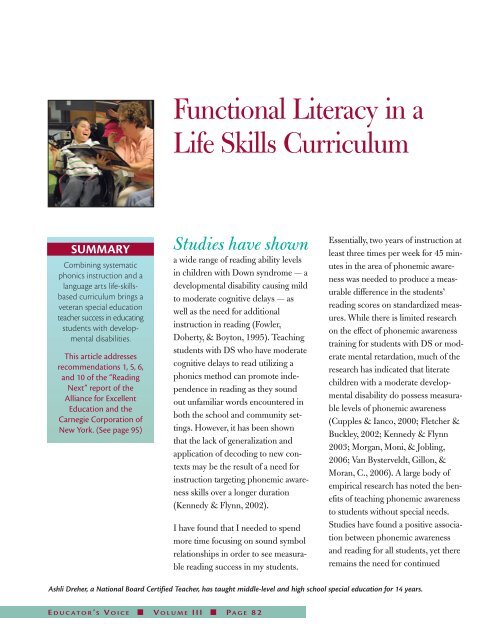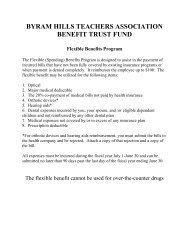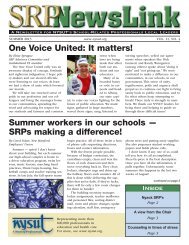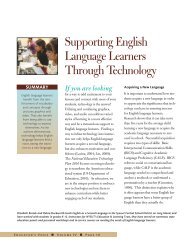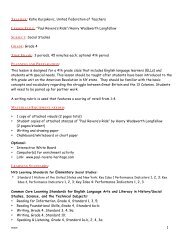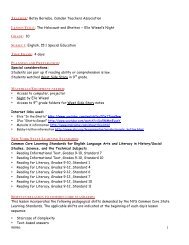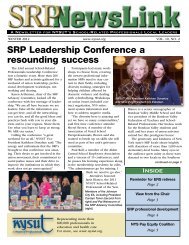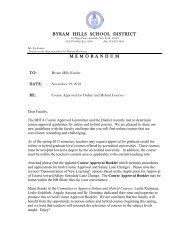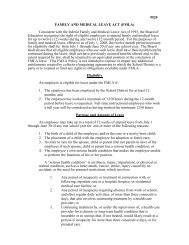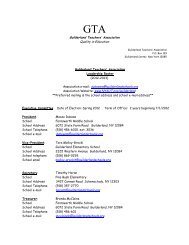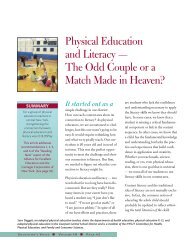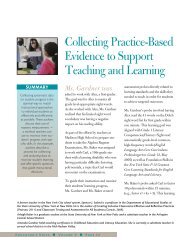Functional Literacy in a Life Skills Curriculum - NYSUT
Functional Literacy in a Life Skills Curriculum - NYSUT
Functional Literacy in a Life Skills Curriculum - NYSUT
Create successful ePaper yourself
Turn your PDF publications into a flip-book with our unique Google optimized e-Paper software.
<strong>Functional</strong> <strong>Literacy</strong> <strong>in</strong> a<br />
<strong>Life</strong> <strong>Skills</strong> <strong>Curriculum</strong><br />
SUMMARY<br />
Comb<strong>in</strong><strong>in</strong>g systematic<br />
phonics <strong>in</strong>struction and a<br />
language arts life-skillsbased<br />
curriculum br<strong>in</strong>gs a<br />
veteran special education<br />
teacher success <strong>in</strong> educat<strong>in</strong>g<br />
students with developmental<br />
disabilities.<br />
This article addresses<br />
recommendations 1, 5, 6,<br />
and 10 of the “Read<strong>in</strong>g<br />
Next” report of the<br />
Alliance for Excellent<br />
Education and the<br />
Carnegie Corporation of<br />
New York. (See page 95)<br />
Studies have shown<br />
a wide range of read<strong>in</strong>g ability levels<br />
<strong>in</strong> children with Down syndrome — a<br />
developmental disability caus<strong>in</strong>g mild<br />
to moderate cognitive delays — as<br />
well as the need for additional<br />
<strong>in</strong>struction <strong>in</strong> read<strong>in</strong>g (Fowler,<br />
Doherty, & Boyton, 1995). Teach<strong>in</strong>g<br />
students with DS who have moderate<br />
cognitive delays to read utiliz<strong>in</strong>g a<br />
phonics method can promote <strong>in</strong>dependence<br />
<strong>in</strong> read<strong>in</strong>g as they sound<br />
out unfamiliar words encountered <strong>in</strong><br />
both the school and community sett<strong>in</strong>gs.<br />
However, it has been shown<br />
that the lack of generalization and<br />
application of decod<strong>in</strong>g to new contexts<br />
may be the result of a need for<br />
<strong>in</strong>struction target<strong>in</strong>g phonemic awareness<br />
skills over a longer duration<br />
(Kennedy & Flynn, 2002).<br />
I have found that I needed to spend<br />
more time focus<strong>in</strong>g on sound symbol<br />
relationships <strong>in</strong> order to see measurable<br />
read<strong>in</strong>g success <strong>in</strong> my students.<br />
Essentially, two years of <strong>in</strong>struction at<br />
least three times per week for 45 m<strong>in</strong>utes<br />
<strong>in</strong> the area of phonemic awareness<br />
was needed to produce a measurable<br />
difference <strong>in</strong> the students’<br />
read<strong>in</strong>g scores on standardized measures.<br />
While there is limited research<br />
on the effect of phonemic awareness<br />
tra<strong>in</strong><strong>in</strong>g for students with DS or moderate<br />
mental retardation, much of the<br />
research has <strong>in</strong>dicated that literate<br />
children with a moderate developmental<br />
disability do possess measurable<br />
levels of phonemic awareness<br />
(Cupples & Ianco, 2000; Fletcher &<br />
Buckley, 2002; Kennedy & Flynn<br />
2003; Morgan, Moni, & Jobl<strong>in</strong>g,<br />
2006; Van Bysterveldt, Gillon, &<br />
Moran, C., 2006). A large body of<br />
empirical research has noted the benefits<br />
of teach<strong>in</strong>g phonemic awareness<br />
to students without special needs.<br />
Studies have found a positive association<br />
between phonemic awareness<br />
and read<strong>in</strong>g for all students, yet there<br />
rema<strong>in</strong>s the need for cont<strong>in</strong>ued<br />
Ashli Dreher, a National Board Certified Teacher, has taught middle-level and high school special education for 14 years.<br />
E D U C A T O R ’ S V O I C E n V O L U M E I I I n P A G E 8 2
Ashli Dreher, Lewiston-Porter United Teachers<br />
research <strong>in</strong> the area of teach<strong>in</strong>g phonics<br />
to students with DS and its relationship<br />
to their acquisition of literacy<br />
(Fowler, Doherty, & Boynton, 1995;<br />
Buckley, Bird, & Byrne, 1996;<br />
Cupples & Ianco, 2000; Conners,<br />
1992; Fletcher & Buckley, 2002;<br />
Joseph & Seery, 2004). Although all<br />
<strong>in</strong>dividuals with Down syndrome<br />
experience cognitive delays, the<br />
delays range from mild to moderate <strong>in</strong><br />
severity. This article will focus on<br />
<strong>in</strong>structional strategies for students<br />
with a moderate developmental delay.<br />
Teach<strong>in</strong>g students with moderate<br />
developmental disabilities to read was<br />
a challeng<strong>in</strong>g task to look forward to<br />
when I began the 2003 school year. As<br />
I met my first group of eager freshman<br />
<strong>in</strong> Lewiston-Porter High School’s new<br />
8:1:1 (eight students, one teacher, and<br />
one teacher aide or teach<strong>in</strong>g assistant)<br />
life skills classroom, all but one of the<br />
students could read little more than<br />
their own name when they walked<br />
<strong>in</strong>to school on the first day of classes.<br />
Dur<strong>in</strong>g the next six school years, however,<br />
five of the six students with<br />
Down syndrome and moderate mental<br />
retardation learned to read and write<br />
at the first-through-third-grade levels.<br />
A comb<strong>in</strong>ed approach utiliz<strong>in</strong>g systematic<br />
phonics <strong>in</strong>struction and a language<br />
arts life-skills-based curriculum provided<br />
the students with the understand<strong>in</strong>g<br />
of the sounds <strong>in</strong> our language as well as<br />
common sight words they would see <strong>in</strong><br />
restaurant-related jobs, at home when<br />
cook<strong>in</strong>g <strong>in</strong> the kitchen, or on packages<br />
at the grocery store. The phonemic<br />
awareness <strong>in</strong>struction occurred three<br />
times each week as whole group lessons,<br />
and <strong>in</strong>struction was differentiated<br />
based on a student’s ability to recognize<br />
letters and sounds. The different ability<br />
groups were <strong>in</strong>structed simultaneously.<br />
PowerPo<strong>in</strong>t slides shown <strong>in</strong> Table 1<br />
were developed to target Level 1 and<br />
Level 2 dur<strong>in</strong>g the lesson, and teacher<br />
aides provided one-to-one assistance to<br />
students work<strong>in</strong>g <strong>in</strong> Level 1. Level 1 of<br />
the phonics program <strong>in</strong>volved construct<strong>in</strong>g<br />
three-letter words with short<br />
vowel sounds, such as cat, cot, cut, tip,<br />
etc. Level 2 students construct threeand<br />
four-letter words with short vowel<br />
sounds, digraph blends (ship, shop,<br />
chip, chop), and blends (flop, flat, flip)<br />
as well as words with welded sounds<br />
(s<strong>in</strong>k, sank, sunk). Level 3 students<br />
beg<strong>in</strong> to learn how to sound out multisyllabic<br />
words conta<strong>in</strong><strong>in</strong>g short vowel<br />
cont<strong>in</strong>ued on follow<strong>in</strong>g page<br />
METHODOLOGY<br />
Do I have to teach<br />
them how to read<br />
Every middle and high<br />
school has some students<br />
who have not yet mastered<br />
the basics of read<strong>in</strong>g. They<br />
may be English language<br />
learners, students with<br />
cognitive disabilities, or<br />
students with bra<strong>in</strong> <strong>in</strong>juries.<br />
These students may receive<br />
support <strong>in</strong> a resource room,<br />
through Academic<br />
Intervention Services, or <strong>in</strong><br />
special education.<br />
But when they are <strong>in</strong> a<br />
regular classroom they may<br />
need assistance with<br />
vocabulary. While the<br />
strategies outl<strong>in</strong>ed here<br />
appear to be for elementaryage<br />
beg<strong>in</strong>n<strong>in</strong>g readers, you<br />
will f<strong>in</strong>d students at this<br />
read<strong>in</strong>g level <strong>in</strong> many<br />
content classrooms.<br />
E D U C A T O R ’ S V O I C E n
<strong>Functional</strong> <strong>Literacy</strong> <strong>in</strong> a <strong>Life</strong> <strong>Skills</strong> <strong>Curriculum</strong><br />
METHODOLOGY<br />
Table 1:<br />
Slide show segment for teach<strong>in</strong>g phonics <strong>in</strong> our classroom,<br />
along with the teacher <strong>in</strong>structions for the class:<br />
Slide 1 Slide 2 Slide 3 Slide 4<br />
cat<br />
Table 2: Lesson Format for 45-M<strong>in</strong>ute Class<br />
Table 2:<br />
sunk<br />
METHODOLOGY<br />
Lesson format for 45-m<strong>in</strong>ute class:<br />
5 m<strong>in</strong>utes Teacher reviews the letters, digraphs, welded sounds<br />
us<strong>in</strong>g a chant: “a-apple-ah,” “b-bell-bah,” etc.<br />
20 m<strong>in</strong>utes Students are asked to construct 10 words us<strong>in</strong>g plastic<br />
alphabet letters. Us<strong>in</strong>g PowerPo<strong>in</strong>t slides, the teacher can<br />
po<strong>in</strong>t to each word and sound them out with the class.<br />
10 m<strong>in</strong>utes Teacher and students read the list of words as a<br />
whole group. Students each have a turn read<strong>in</strong>g<br />
the list of words aloud.<br />
10 m<strong>in</strong>utes Teacher keeps the list of words on the screen,<br />
read<strong>in</strong>g one at a time. Students write the word read<br />
next to each number on their paper.<br />
sounds. A differentiated approach to<br />
phonics <strong>in</strong>struction can be applied to any<br />
elementary classroom or <strong>in</strong>structional situation<br />
where you are teach<strong>in</strong>g students<br />
with vary<strong>in</strong>g phonemic awareness abilities.<br />
Students may use plastic alphabet letters<br />
or a dry erase board and markers to<br />
construct the words they will be asked to<br />
read and write dur<strong>in</strong>g the lesson.<br />
n Show a blank slide (Slide 1) and tell<br />
students <strong>in</strong> the first group to make the<br />
word “cat.” The teacher aides will<br />
sound out the word until students<br />
have spelled it correctly. Instruct students<br />
<strong>in</strong> the second group to make<br />
the work “sunk.” Sound out the word<br />
until students have made the word.<br />
n Move on to Slide 2 and ask the class<br />
to sound out the word. The teacher<br />
should po<strong>in</strong>t to each letter as the<br />
sound of the letter is made.<br />
n Show Slide 3 and ask the students to<br />
sound out the word as you po<strong>in</strong>t to<br />
each letter and say its sound.<br />
n Project blank Slide 4 and have students<br />
complete the second group of<br />
words. Repeat this procedure until<br />
all 10 words have been constructed.<br />
A chart <strong>in</strong>dicat<strong>in</strong>g the lesson time frame<br />
and activities is <strong>in</strong>cluded <strong>in</strong> Table 2.<br />
After students have constructed their<br />
words, each student will read the group<br />
of words aloud. A PowerPo<strong>in</strong>t slide<br />
should be shown with all of the Level 2<br />
words listed. The teacher will po<strong>in</strong>t to<br />
each word and assist students as they<br />
E D U C A T O R ’ S V O I C E n V O L U M E I I I n P A G E 8 4
ead the list of words. Students then<br />
complete a brief assessment as the<br />
teacher reads the words <strong>in</strong> random<br />
order and students copy the correct<br />
word on to their paper from the projected<br />
list of words. If students have<br />
more than two words <strong>in</strong>correct, the<br />
lesson should be repeated for mastery.<br />
Level 1 students should work one-onone<br />
with an assistant, if needed, and<br />
have their words written on Post-it<br />
notes to read from. When they take<br />
their test, they will be read a random<br />
word from the lesson. They will be<br />
asked to select the correct Post-it note<br />
conta<strong>in</strong><strong>in</strong>g the word and place it next<br />
to the number on their test paper.<br />
Then, the student will write the word<br />
on their paper.<br />
It is important for students with<br />
developmental disabilities to recognize<br />
functional words with<strong>in</strong> the community;<br />
however students also need<br />
<strong>in</strong>struction utiliz<strong>in</strong>g a direct approach<br />
<strong>in</strong> phonemic awareness that can be<br />
generalized with<strong>in</strong> their community<br />
and classrooms. In addition to explicit<br />
phonemic awareness <strong>in</strong>struction, a<br />
balanced literacy program that<br />
<strong>in</strong>cludes the use of materials already<br />
<strong>in</strong> place <strong>in</strong> the school environment,<br />
such as trade books and magaz<strong>in</strong>es,<br />
will afford students a rich literary<br />
experience grounded <strong>in</strong> everyday<br />
practice as they move from a logographic<br />
stage of read<strong>in</strong>g to <strong>in</strong>clude the<br />
alphabetic and orthographic stages of<br />
read<strong>in</strong>g development. With these<br />
thoughts <strong>in</strong> m<strong>in</strong>d I began a search for<br />
a life-skills-based curriculum that<br />
would enable students to learn to utilize<br />
the oven, microwave, and other<br />
small appliances <strong>in</strong> our classroom<br />
kitchen. A program called “Cook<strong>in</strong>g<br />
to Learn 2 — Integrated Read<strong>in</strong>g and<br />
Writ<strong>in</strong>g Activities” by Coxson and<br />
Nilson was added to our classroom<br />
<strong>in</strong>structional rout<strong>in</strong>e. Directions and<br />
comprehension questions are <strong>in</strong>cluded<br />
for each lesson, both with and<br />
without illustrations. For students <strong>in</strong><br />
class who struggle with read<strong>in</strong>g, the<br />
worksheets are scanned and used with<br />
Read and Write Gold, a computer<br />
software program that will highlight<br />
and read each word aloud for the<br />
students. Table 3 illustrates the<br />
differentiation provided by this<br />
“hands-on” method to <strong>in</strong>crease<br />
functional sight word awareness.<br />
Table 3: Food and Cook<strong>in</strong>g Items<br />
to Make a Morn<strong>in</strong>g Surprise<br />
Each section of the lesson <strong>in</strong>cludes<br />
picture cues for students. Table 4 outl<strong>in</strong>es<br />
specific steps <strong>in</strong> the <strong>in</strong>structional<br />
process <strong>in</strong>volved <strong>in</strong> complet<strong>in</strong>g the<br />
recipe-based lesson. One page conta<strong>in</strong>s<br />
illustrations of each direction for<br />
emergent readers; the other page has<br />
no illustrations for students with a<br />
basic read<strong>in</strong>g skill level.<br />
cont<strong>in</strong>ued on follow<strong>in</strong>g page<br />
A differentiated<br />
approach to<br />
phonics <strong>in</strong>struction<br />
can be<br />
applied to any<br />
elementary<br />
classroom or<br />
<strong>in</strong>structional<br />
situation where<br />
you are teach<strong>in</strong>g<br />
students with<br />
vary<strong>in</strong>g phonemic<br />
awareness<br />
abilities.<br />
E D U C A T O R ’ S V O I C E n V O L U M E I I I n P A G E 8 5
<strong>Functional</strong> <strong>Literacy</strong> <strong>in</strong> a <strong>Life</strong> <strong>Skills</strong> <strong>Curriculum</strong><br />
METHODOLOGY<br />
Table 3:<br />
Food and Cook<strong>in</strong>g Items to Make a Morn<strong>in</strong>g Surprise<br />
METHODOLOGY<br />
Table 4:<br />
Step-by-Step directions for mak<strong>in</strong>g Macaroni and Cheese<br />
Table 4: Step-by-Step Directions<br />
for Mak<strong>in</strong>g Macaroni and Cheese<br />
At the end of each cook<strong>in</strong>g lesson,<br />
there are comprehension questions<br />
for students to complete, a cloze<br />
activity, as well as a reflective th<strong>in</strong>k<strong>in</strong>g<br />
writ<strong>in</strong>g assignment, which asks students<br />
to recap what they did <strong>in</strong> class<br />
as shown <strong>in</strong> Table 5. The comprehension<br />
questions, as illustrated <strong>in</strong><br />
Table 6 are also differentiated.<br />
Emergent writers may give a one- or<br />
two-word answer, which is scribed by<br />
a teacher and traced by the student.<br />
Other students give shortened<br />
answers, which the teacher should<br />
say aloud <strong>in</strong> a complete sentence and<br />
write on an overhead so that students<br />
can see examples of how writers leave<br />
spaces between words, write <strong>in</strong> a leftto-right<br />
pattern, and read the <strong>in</strong>formation<br />
they are writ<strong>in</strong>g.<br />
Table 5: Sample Cloze Activity<br />
and Comprehension Questions<br />
Table 6: Differentiated<br />
Comprehension Question<br />
Activities<br />
In all aspects of the <strong>in</strong>structional program,<br />
teach<strong>in</strong>g assistants have been an<br />
<strong>in</strong>tegral part of the success our students<br />
experienced <strong>in</strong> the acquisition<br />
of literacy. The TAs attend tra<strong>in</strong><strong>in</strong>gs<br />
with the teacher to learn important<br />
skills implemented <strong>in</strong> the classroom,<br />
and the Lewiston-Porter School<br />
District has provided the School-<br />
Related Professional <strong>in</strong> the high<br />
E D U C A T O R ’ S V O I C E n V O L U M E I I I n P A G E 8 6
school with laptops and computer<br />
tra<strong>in</strong><strong>in</strong>g as well. This has proven<br />
extremely helpful <strong>in</strong> my ability to use<br />
assistive technology that the TAs must<br />
be familiar with if emergent readers are<br />
to be active participants <strong>in</strong> the phonics<br />
and cook<strong>in</strong>g lessons. A close-knit,<br />
professional learn<strong>in</strong>g community<br />
where TAs and special education<br />
teachers share ideas and <strong>in</strong>put is a<br />
necessary condition to beg<strong>in</strong> collaborat<strong>in</strong>g<br />
on <strong>in</strong>structional strategies and<br />
implementation.<br />
A lack of read<strong>in</strong>g opportunities that<br />
fails to immerse the child <strong>in</strong> a literacyfilled<br />
environment and explicit read<strong>in</strong>g<br />
<strong>in</strong>struction that does not cont<strong>in</strong>ue<br />
beyond basic skills <strong>in</strong> read<strong>in</strong>g perpetuate<br />
the marg<strong>in</strong>alization of <strong>in</strong>dividuals<br />
with disabilities. There are major<br />
implications for develop<strong>in</strong>g a sound,<br />
research-based literacy program for<br />
students with developmental disabilities.<br />
Students will have the ability to be<br />
readers and function more <strong>in</strong>dependently<br />
<strong>in</strong> the community if they can<br />
sound out and comprehend unfamiliar<br />
words. Employment opportunities will<br />
<strong>in</strong>crease, and the students’ abilities to<br />
manage their lives without assistance<br />
will improve as well.<br />
METHODOLOGY<br />
Table 5:<br />
Sample Cloze Activity and Comprehension Questions<br />
METHODOLOGY<br />
Table 6:<br />
Differentiated Comprehension Question Activities<br />
Students <strong>in</strong> the 8:1:1 class at<br />
Lewiston-Porter High School took<br />
great pride <strong>in</strong> read<strong>in</strong>g selections for<br />
their parents at our classroom d<strong>in</strong>ners<br />
and select<strong>in</strong>g books to read for pleasure,<br />
both at school and home.<br />
cont<strong>in</strong>ued on follow<strong>in</strong>g page<br />
E D U C A T O R ’ S V O I C E n V O L U M E I I I n P A G E 8 7
<strong>Functional</strong> <strong>Literacy</strong> <strong>in</strong> a <strong>Life</strong> <strong>Skills</strong> <strong>Curriculum</strong><br />
Generaliz<strong>in</strong>g the<br />
skill of decod<strong>in</strong>g<br />
and learn<strong>in</strong>g to<br />
th<strong>in</strong>k about the<br />
messages that<br />
words and<br />
sentences are<br />
convey<strong>in</strong>g will<br />
create additional<br />
opportunities for<br />
<strong>in</strong>dependence for<br />
special-needs<br />
students with<br />
moderate<br />
developmental<br />
disabilities.<br />
Witness<strong>in</strong>g the joy of the mothers and<br />
fathers of students who, until high<br />
school, had not heard their children<br />
read <strong>in</strong>dependently, is someth<strong>in</strong>g I<br />
will never forget. Not only were students<br />
able to read directions for life<br />
skills purposes such as cook<strong>in</strong>g, they<br />
enjoyed read<strong>in</strong>g stories, notes from<br />
their parents, and birthday <strong>in</strong>vitations<br />
from classmates. Generaliz<strong>in</strong>g the skill<br />
of decod<strong>in</strong>g and learn<strong>in</strong>g to th<strong>in</strong>k<br />
about the messages that words and<br />
sentences convey creates additional<br />
opportunities for <strong>in</strong>dependence for<br />
special-needs students.<br />
REFERENCES<br />
Adams, M. J., All<strong>in</strong>gton, R., Chaney, J.,<br />
Goodman, Y., Kap<strong>in</strong>us, B., McGee, L.,<br />
Richgels, D., Schwartz, S., Shannon, P.,<br />
Smitten, B., Williams, J. (1991). Beg<strong>in</strong>n<strong>in</strong>g<br />
to read: A critique by literary professionals<br />
and a response by Marilyn Adams. The<br />
Read<strong>in</strong>g Teacher 44(6), 371-395.<br />
Buckley, S., Bird, G., and Byrne, A. (1996).<br />
The practical and theoretical significance<br />
of teach<strong>in</strong>g literacy skills to children with<br />
Down syndrome. In J.A. Rondal, J. Perera,<br />
L. Nadel, & A. Combla<strong>in</strong> (Eds), Down<br />
syndrome: psychological, psychobiological,<br />
and socio-educational perspectives<br />
(pp. 119-128). London: Whurr.<br />
Coxson, L & Nilson, C. (2001). Cook<strong>in</strong>g to<br />
Learn 2: Integrated Read<strong>in</strong>g and Writ<strong>in</strong>g<br />
Activities. PCI Educational Publish<strong>in</strong>g.<br />
Cupples, L. & Ianco, T. (2000). Phonological<br />
awareness and oral read<strong>in</strong>g skills <strong>in</strong> children<br />
with Down syndrome. Journal of<br />
Speech, Language, and Hear<strong>in</strong>g Research<br />
43(3), 595-608.<br />
Fletcher, H. & Buckley, S. (2002).<br />
Phonological awareness of children with<br />
Down syndrome. Down Syndrome<br />
Research and Practice 8(1), 11-18.<br />
Fowler, A.E., Doherty, B.J., & Boynton, L.<br />
(1995). The basis of read<strong>in</strong>g skill <strong>in</strong> young<br />
adults with Down syndrome. In L. Nadel<br />
& D. Rosenthal (Eds.), Down syndrome:<br />
Liv<strong>in</strong>g and learn<strong>in</strong>g <strong>in</strong> the community (pp.<br />
182-196). New York: Wiley-Liss.<br />
E D U C A T O R ’ S V O I C E n V O L U M E I I I n P A G E 8 8
Green, B. & Kostogriz, A. (2002). Learn<strong>in</strong>g<br />
difficulties and the New <strong>Literacy</strong> Studies:<br />
A socially critical perspective. In J. Soler, J.<br />
Wearmouth & G. Reid (Eds.),<br />
Contextualiz<strong>in</strong>g difficulties <strong>in</strong> literacy<br />
development: Explor<strong>in</strong>g politics, culture,<br />
ethnicity and ethics (pp. 102-114),<br />
London: RoutledgeFalmer.<br />
Joseph, L., & Seery, M. (2004). Where is the<br />
phonics A review of the literature on the<br />
use of phonetic analysis with students with<br />
mental retardation. Remedial and Special<br />
Education, 25(2), 88-94.<br />
Kennedy, E.J. & Flynn, M.C. (2003).<br />
Tra<strong>in</strong><strong>in</strong>g phonological awareness skills <strong>in</strong><br />
children with Down syndrome. Research <strong>in</strong><br />
Developmental Disabilities, 24(1), 44-57.<br />
Liberman, I.Y., Shankweiler, D., &<br />
Liberman, A.M. (1989). The alphabetic<br />
pr<strong>in</strong>ciple and learn<strong>in</strong>g to read.<br />
Repr<strong>in</strong>ted from “Phonology and read<strong>in</strong>g<br />
disability: Solv<strong>in</strong>g the read<strong>in</strong>g puzzle.”<br />
International Academy for Research <strong>in</strong><br />
Learn<strong>in</strong>g Disabilities Monograph Series.<br />
Morgan, M., Moni, K., & Jobl<strong>in</strong>g, M.A.<br />
(2006). Code-breaker: Develop<strong>in</strong>g phonics<br />
with a young adult with an <strong>in</strong>tellectual disability.<br />
Journal of Adolescent & Adult<br />
<strong>Literacy</strong> 50(1), 52-65.<br />
Thomas, G, & Loxley, A. (2001). Th<strong>in</strong>k<strong>in</strong>g<br />
about learn<strong>in</strong>g failure, especially <strong>in</strong> read<strong>in</strong>g.<br />
In G. Thomas & A. Loxley,<br />
Deconstruct<strong>in</strong>g special education and<br />
construct<strong>in</strong>g <strong>in</strong>clusion (pp. 65-75).<br />
Buck<strong>in</strong>gham, UK: Open University Press.<br />
Van Bysterveldt, A.K., Gillon, G.T., &<br />
Moran, C. (2006). Enhanc<strong>in</strong>g phonological<br />
awareness and letter knowledge <strong>in</strong> preschool<br />
children with Down syndrome.<br />
International Journal of Disability,<br />
Development, and Education 53(3).<br />
E D U C A T O R ’ S V O I C E n V O L U M E I I I n P A G E 8 9


